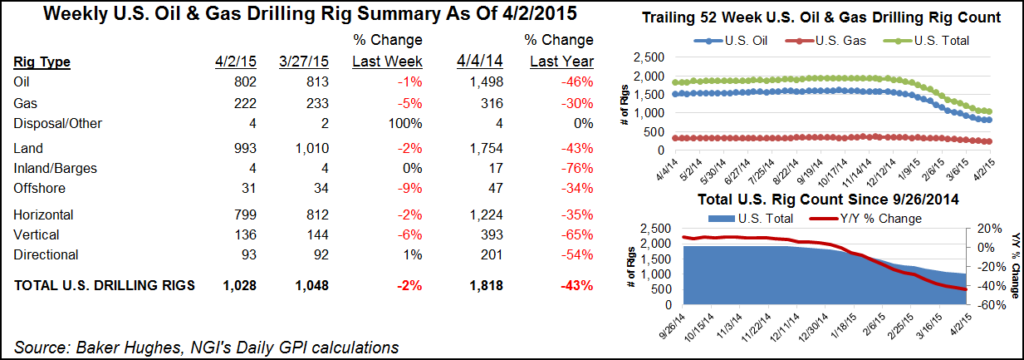U.S., Canada Rig Decline Copies Last Week’s
Perhaps the rate of decline in operating rotary drilling rigs is leveling off if data for the week ending Thursday April 2 is any indication. Declines in the United States and Canada were about the same in the last two rig counts.

According to Thursday’s rotary rig count from Baker Hughes Inc. the United States and Canada each lost 20 rigs during the preceding week. The previous count had the U.S. down by 21 and Canada down by 20.
In the United States, natural gas and oil each gave up 11 rigs in the latest count, which was issued a day early due to the Good Friday holiday. Only eight vertical rigs were lost compared with 13 horizontals, but that probably reflects the fact that most verticals hit the trail a while back, leaving only 136 running in the latest count compared with 799 horizontals still active. The directional rig count gained one to 93.
The rigs that remain on the job still are producing too much for a recovery in prices. “We have to slow U.S. oil production growth close to zero, not production, but production growth,” said Credit Suisse LLC’s James Wicklund at a Houston forum hosted by law firm BoyarMiller. The U.S. horizontal rig count needs to drop by 30-35% and stay at that level for four to eight quarters to get U.S. production growth to zero, Wicklund said.
The U.S. offshore count was down three to 31, which is off 16 from a year ago when the count was 47. The Gulf of Mexico was the only region in the United States to register natural gas production growth in January, the Energy Information Administration said in a recent report (see Daily GPI, April 1).
In Canada, 22 natural gas-directed rigs were lost while the oil-directed tally added two.
North Dakota and Texas lost the most rigs in the latest count, giving up six each. While Louisiana was the second-biggest loser, dropping five to land at 67. A week prior when Louisiana’s count was at 72, the Louisiana Oil & Gas Association’s Ben Broussard said in a webcast that it was the lowest point in recorded history in the Pelican State.
© 2024 Natural Gas Intelligence. All rights reserved.
ISSN © 1532-1231 | ISSN © 2577-9877 |
